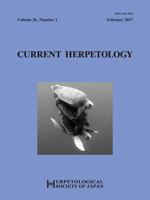Most lizards have well developed auditory abilities, while not actually vocalizing to any extent outside of geckos. However, except for geckos, function of hearing in lizards has not been well investigated. Recently, the ability to eavesdrop on the alarm calls of a syntopic avian species has been demonstrated in four species of lizards that belong to different families. This suggests that eavesdropping is a major function of hearing in lizards. To examine this possibility we tested the ability of heterospecific eavesdropping by a lizard that belongs to another family in an Ampijoroa forest of Madagascar, where two lizard species have been known to show this ability. We experimentally tested whether Zonosaurus laticaudatus, a gerrhosaurid lizard, has the ability to eavesdrop on the alarm calls of the Madagascar paradise flycatcher. In the experiment, we provided bait on the ground in front of free-ranging zonosaurs to induce their foraging activity and played back alarm calls or songs of the bird to them. The number of individuals that stopped foraging in response to the alarm calls was larger than that in response to the songs. Similarly, the number of individuals that fled in response to the alarm calls was larger than that in response to the songs. The zonosaurs stopped foraging for a longer time in response to the alarm calls than to the songs. These results demonstrate that Z. laticaudatus has the ability to eavesdrop on alarm calls of the Madagascar paradise flycatcher. It is suggested that heterospecific eavesdropping by non-vocal lizards is a common phenomenon, at least, in the Ampijoroa forest of Madagascar.
How to translate text using browser tools
1 February 2017
How Common is Heterospecific Eavesdropping in Lizards? Test Using a Madagascan Gerrhosaurid
Ryo Ito,
Tsiry Randrianarisoa,
Akira Mori
ACCESS THE FULL ARTICLE

Current Herpetology
Vol. 36 • No. 1
February 2017
Vol. 36 • No. 1
February 2017
Ampijoroa forest
Avian alarm calls
heterospecific eavesdropping
Non-social lizard
Saurian hearing sense




